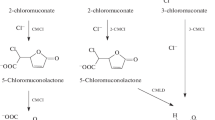Abstract
The ability to O-methylate chlorinated phenols and phenol derivatives in the genus Rhodococcus was studied. Several species and strains O-methylated chlorophenols to the corresponding anisoles, namely R. equi, R. erythropolis, R. rhodochrous, and Rhodococcus sp. strains P1 and An 117. The ability for a strain to O-methylate chlorophenols did not require that it had been isolated from an environment containing a chlorinated aromatic compound. O-methylation activity was stimulated by the presence of carbohydrate. All strains preferentially O-methylated a substrate with the hydroxyl group flanked by two chlorine substitunts.
Similar content being viewed by others
References
Allard A-S, Remberger M, Neilson AH (1985) Bacterial O-methylation of chloroguaiacols: effect of substrate concentration, cell density, and growth conditions. Appl Environ Microbiol 49: 279–288
Allard A-S, Remberger M, Neilson AH (1987) Bacterial O-methylation of halogen substituted phenols. Appl Environ Microbiol 53:839–845
Apajalahti JHA, Salkinoja-Salonen MS (1986) Degradation of chlorinated phenols by Rhodococcus chlorophenolicus. Appl Microbiol Biotechnol 25:62–67
Bemelmans JMH, ten Noever de Brauw MC (1974) Chloroanisoles as off-flavor components in eggs and broilers. J Agric Food Chem 22:1137–1138
Borchardt RT (1980) N-and O-methylation. In: Jakobi WB (ed) Enzymatic basis of detoxication, vol II. Academic Press, New York, pp 43–62
Cserjesi AJ, Johnson EL (1972) Methylation of pentachlorophenol by Trichoderma virgatum. Can J Microbiol 18:45–49
Claus D, Lack P, Neu B (eds) (1983) German Collection of Microorganisms. Catalog of strains, third edn. Gesellschaft für Biotechnologische Forschung MBH, Braunschweig, FRG
Gee JM, Peel JL (1974) Metabolism of 2,3,4,6-tetrachlorophenol by microorganisms from broiler house litter. J Gen Microbiol 85:237–243
Goodfellow M (1986) Genus Rhodococcus. In: Sneath PHA, Mair NS, Sharpe ME, Holt JG (eds) Bergeys manual of systematic bacteriology. Williams & Wilkins, Baltimore, pp 1472–1481
Hensel J, Straube G (1983) Physiologie des Phenolabbaus bei Rhodococcus spec P1. Teil 1. Beziehungen zwischen Wachstum and Phenolabbau. Acta Hydrochim Hydrobiol 11:637–645
Häggblom M, Apajalahti J, Salkinoja-Salonen M (1986) Metabolism of chloroguaiacols by Rhodococcus chlorophenolicus. Appl Microbiol Biotechnol 24:397–404
Häggblom MM, Apajalahti JHA, Salkinoja-Salonen MS (1988a) Hydroxylation and dechlorination of chlorinated guaiacols and syringols by Rhodococcus chlorophenolicus. Appl Environ Microbiol 54:683–687
Häggblom MM, Apajalahti JHA, Salkinoja-Salonen MS (1988b) O-Methylation of chlorinated para-hydroquinones by Rhodococcus chlorophenolicus. Appl Environ Microbiol 54:1818–1824
Häggblom MM, Nohynek LJ, Salkinoja-Salonen MS (1988c) Degradation and O-methylation of chlorinated phenolic compounds by Rhodococcus and Mycobacterium strains. Appl Environ Microbiol 54:3043–3052
Janke D, Fritsche W (1985) Nature and significance of microbial cometabolism of xenobiotics. J Basic Microbiol 25:603–619
Kuwatsuka S, Igarashi M (1975) Degradation of PCP in soils. Soil Sci Plant Nutr 21:405–414
Murthy NBK, Kaufman DD, Fries GF (1979) Degradation of pentachlorophenol (PCP) in anaerobic soil. J Environ Sci Health B 14:1–14
Neilson AH, Allard A-S, Hynning P-Å, Remberger M, Landner L (1983) Bacterial methylation of chlorinated phenols and guaiacols: formation of veratroles from guaiacols and highmolecular-weight chlorinated lignin. Appl Environ Microbiol 45:774–783
Neilson AH, Allard A-S, Reiland S, Remberger M, Tärnholm A, Viktor T, Landner L (1984) Tri- and tetrachloroveratrole, metabolites produced by bacterial O-methylation of tri- and tetrachloroguaiacol: an assessment of their bioconcentration potential and their effects on fish reproduction. Can J Fish Aquat Sci 41:1502–1512
Neilson AH, Lindgren C, Hynning P-A, Remberger M (1988) Methylation of halogenated phenols and thiophenols by cell extracts of gram-positive and gram-negative bacteria. Appl Environ Microbiol 54:524–530
Paasivirta J, Klein P, Knuutila M, Knuutinen J, Lahtiperä M, Paukku R, Veijanen A, Welling L, Vuorinen M, Vuorinen PJ (1987) Chlorinated anisoles and veratroles in fish. Model compounds. Instrumental sensory determinations. Chemosphere 16:1231–1241
Peczynska-Czoch W, Morkarski M (1983) Transformation of xenobiotics. In: Goodfellow M, Mordarski M, Williams ST (eds) The biology of the actinomycetes. Academic Press, London, pp 287–336
Renberg L, Marell E, Sundström G, Adolfson-Erici M (1983) Levels of chlorophenols in natural waters and fish after an accidental discharge of a wood-impregnating solution. Ambio 12:121–123
Schukat B, Janke D, Krebs D, Fritsche W (1983) Cometabolic degradation of 2- and 3-chloroaniline because of glucose metabolism by Rhodococcus sp. An 117. Current Microbiol 9:81–86
Somani SM, Smart T, Khalique A (1984) Metabolism of 2,4-dichlorophenol by isolated perfused rat liver. J Toxicol Environ Health 13:787–798
Sundman V (1964) A description of some lignanolytic soil bacteria and their ability to oxidize simple phenolic compounds. J Gen Microbiol 36:171–183
Suzuki T (1978) Enzymatic methylation of pentachlorophenol and its related compounds by cell-free extracts of Mycobacterium sp. isolated from soil. J Pestic Sci 3:441–443
Suzuki T (1983) Methylation and hydroxylation of pentachlorophenol by Mycobacterium sp. isolated from soil. J Pestic Sci 8:419–428
Valo R, Salkinoja-Salonen M (1986) Microbial transformation of polychlorinated phenoxy phenols. J Gen Appl Microbiol 32: 505–517
Whitfield FB, McBride RL, Nguyen THL (1987) Flavour perception of chloroanisoles in water and selected processed foods. J Sci Food Agric 40:357–365
Wiese MV, Vargas JM Jr (1973) Interconversion of chloroneb and 2,5-dichloro-4-methoxyphenol by soil microorganisms. Pestic Biochem Physiol 3:214–222
Author information
Authors and Affiliations
Rights and permissions
About this article
Cite this article
Häggblom, M.M., Janke, D., Middeldorp, P.J.M. et al. O-methylation of chlorinated phenols in the genus Rhodococcus . Arch. Microbiol. 152, 6–9 (1989). https://doi.org/10.1007/BF00447003
Received:
Accepted:
Issue Date:
DOI: https://doi.org/10.1007/BF00447003




